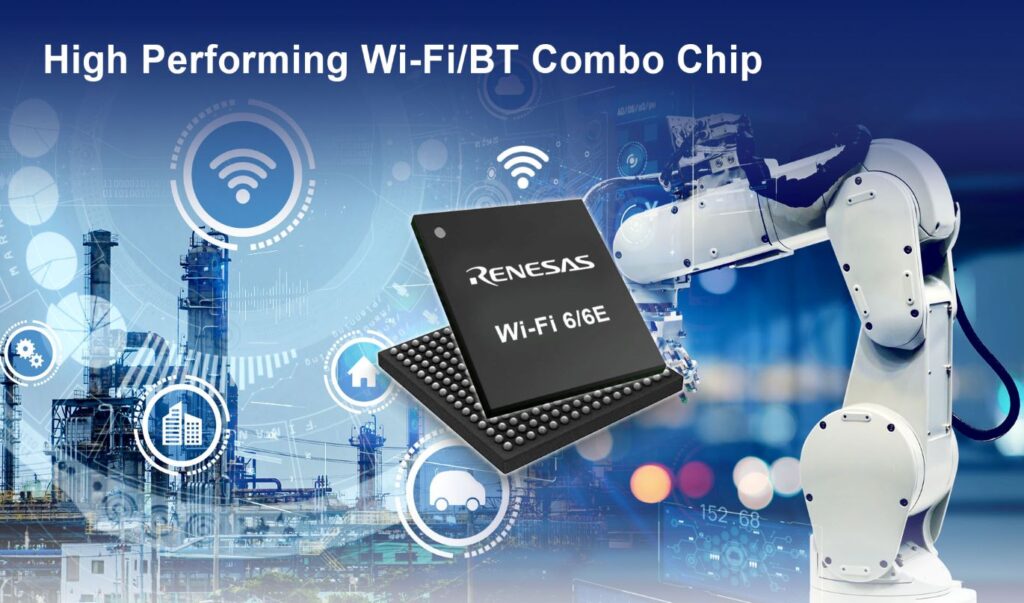ASIA ELECTRONICS INDUSTRYYOUR WINDOW TO SMART MANUFACTURING
Renesas' New Wi-Fi Roadmap to Suit Industrial Needs
Renesas Electronics Corporation has unveiled plans to deliver a comprehensive set of advanced Wi-Fi offerings to complement its broad portfolio of Industrial and IoT products.
Recently, Renesas completed its acquisition of Celeno. Hence, the company is leveraging that technology to address a wide range of Wi-Fi client and access point applications for Wi-Fi 6/6E and Wi-Fi 7.
Now, Renesas is delivering production volumes of high-performance Wi-Fi 6E access point solutions with its CL8000 family. Renesas is also sampling a powerful, highly integrated, 2×2 Wi-Fi/BLE combo chip supporting Wi-Fi 6E tri-band switchable radio (6GHz, 5GHz & 2.4GHz), 160MHz channel bandwidth and up to 2.4Gbps Data Link Speed. The new low-latency, highly secure chipset includes Bluetooth and BLE 5.2 support. In addition, it addresses multimedia streaming applications, IoT gateways and cloud connected devices.

Renesas is also developing a Wi-Fi 6E chipset with unique, patented Wi-Fi Doppler Imaging technology. This Wi-Fi Radar technology depicts the range and doppler signature of people and objects using standard Wi-Fi signals. Furthermore, it eliminates the need for multiple cameras or sensors in home environments and commercial buildings. For example, it can detect the presence and location of people in a room to redirect and optimize air-conditioning flows, saving on energy costs.
Another example is intrusion detection to secured facilities or connected cameras with motion sensing to activate the camera. The combined connectivity and sensing chip is due for production in the next 18 months.
Offers More Reliable Network
Wi-Fi 7, also known as Extremely High Throughput (EHT), will deliver significantly faster throughput by employing faster modulations and double the bandwidth. In the 6GHz band, Wi-Fi 7 would more than double the maximum speed and will increase speeds in the 2.4GHz and 5GHz band by as much as 30 percent. More importantly, some prominent features of Wi-Fi 7 will improve network reliability, latency, and user experience.
For example, by delivering Multi Link Operation, devices would monitor multiple links across different bands and provide consolidated operation to optimize interference and retransmission avoidance.
Users will benefit from more reliable networks and from lower and more predictable latency. The industry expects to see the launch of Wi-Fi 7 in 2024. Particularly, the early adoption in mobile phones, computers, and networking devices. Broader adoption in IoT, industrial and consumer multimedia applications will follow.
Renesas’ Wi-Fi 7 offerings will include solutions for home networking, IoT, industrial and consumer multimedia devices.
“Renesas can now offer truly differentiated Wi-Fi solutions that provide maximum performance, security and cost-competitiveness in combination with our industry-leading MCU and MPU offerings,” said Gilad Rozen, Celeno CEO and Vice President of Wi-Fi Connectivity in Renesas’ IoT and Infrastructure Business Unit.
In addition, Sailesh Chittipeddi, Executive Vice President and General Manager of the IoT and Infrastructure Business Unit of Renesas, said, “In the past year, we have completed three acquisitions that significantly augment our ability to sustainably provide intelligence from the cloud to the endpoint.”
Winning Combinations
Renesas offers numerous Winning Combinations that combine Wi-Fi 6 and 6E chipsets integrated with a broad range of solutions from Renesas. This includes embedded processing, analog, power, timing and connectivity products. These engineering-vetted Winning Combinations will span applications from a High Throughput Wi-Fi 6 Router for home gateways to a Wireless IEEE 1588 Solution for 5G networks. More Winning Combos with Wi-Fi 6 are under development, including a Video IP Phone, Smart Home Security Terminal, and expansion of the Renesas Quick-Connect IoT Platform to include a Wi-Fi 6 USB stick for users to rapidly build prototypes.
In addition, a new Quick-Connect Wi-Fi 6 and Bluetooth Low Energy 5.2 module will be released for IoT applications that need a high bandwidth, high performance Wi-Fi 6 Client with 2×2 MIMO. This fully integrated, RF-qualified module will feature a flexible footprint with both PCIe and USB interfaces, saving engineering time and streamlining procurement for faster time-to-market.




